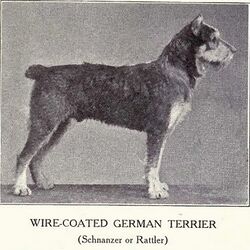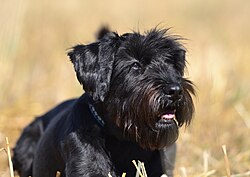Biology:Standard Schnauzer
The Schnauzer or Mittelschnauzer is a German breed of dog in the Pinscher and Schnauzer group.[1] It is characterised by an abundant bristly beard and whiskers, usually lighter than the coat. It is one of three Schnauzer breeds, the others being the Giant Schnauzer or Riesenschnauzer, and the Miniature Schnauzer or Zwergschnauzer. In Germany it is an endangered breed, and is listed in category III of the Rote Liste of the Gesellschaft zur Erhaltung alter und gefährdeter Haustierrassen.[2]
Its development as a breed dates from the 1880s, in southern Germany.[3]:40 It is a robust and squarely-built dog of medium size, of working or utility type; the coat may be salt-and-pepper or black. A dog of this type was exhibited in Hanover in 1879; another was "Best in Show" at the Westminster Kennel Club in the United States in 1997.[4]
Breed name
The name of the breed derives from the German word schnauz, meaning 'snout',[citation needed] but how it came to be applied to the breed is unknown.[5]:482 The word schnauzer appears in the Bilder und Sagen aus der Schweiz of Jeremias Gotthelf, published in 1842.[5]:482 'Schnauz' was a common name for a dog – several dogs with this name were shown in Elberfeld in 1880.[6]:149 At the third international dog show of the Verein zur Veredelung der Hunderassen in Hanover in 1879, a dog named 'Schnautzer' took first place in the Rauche Pinscher or Wire-haired Pinscher class.[6]:149 The name of the breed was officially changed from Rauhaarige Pinscher to Schnauzer with the sixth edition of the stud-book in 1917.[5]:482
History
The Schnauzer originated in southern Germany;[7] it shares a common history with the German Pinscher.[8] Dogs of this type, both rough-haired and smooth-haired, were traditionally kept as carriage dogs or as stable dogs, and so were sometimes known as Stallpinscher; they were capable ratters.[8] Both types were known as Deutscher Pinscher, and came from the same lineage; rough-haired and smooth-haired puppies could occur in the same litter.[8] The rough-haired type, which would later become the Schnauzer, was also known as the Rattler.[8][9]:152
In 1880 the Pinscher was recorded in the Deutschen Hundestammbuch of the Verein zur Veredelung der Hunderassen,[10] and the first breed standard was drawn up.[5]:482 Various colours were described for the rough-haired type, including iron-grey, silver-grey, grey-yellow, corn-yellow and rust-yellow.[5]:482 In 1895 Ludwig Beckmann (painter) (de) described five varieties of Pinscher – the rough- and smooth-haired Pinscher, the rough- and smooth-haired Miniature Pinscher, and the Affenpinscher.[8][9]:152 Also in 1895, a breed society, the Pinscherklub, was established for both types, both rough- and smooth-haired.[10][11] Another society, the Schnauzerklub München, was formed in Munich in 1907 by breeders of the Mittelschnauzer.[11] In 1917, with the sixth edition of the stud-book, the name of the rough-haired breed was officially changed from Rauhaarige Pinscher to Schnauzer.[5]:482 In 1918 the Pinscherklub and the Schnauzerklub München merged to form the Pinscher-Schnauzer-Verband, which in 1921 changed its name to the present Pinscher-Schnauzer-Klub 1895 e.V.[11]
In the interwar period the pepper-and-salt Schnauzer flourished, while the black was less often seen; after the end of the Second World War, the reverse was true.[11] The Schnauzer was definitively accepted by the Fédération Cynologique Internationale in 1955.[12] In the fifteen-year period from 2007 to 2021, annual registrations in Germany varied between 370 and 582, with an annual average of 464.[13]
Since 2014 the pepper-and-salt Schnauzer has been on the Rote Liste of the Gesellschaft zur Erhaltung alter und gefährdeter Haustierrassen.[14] In 2022 its conservation status was listed as gefährdet, 'endangered', the third-highest category of endangerment of the organisation.[2] In 2018 a total of 201 pepper-and-salt puppies were whelped in 26 litters.[15]
A few Schnauzers were exported to the United States before the outbreak of the First World War. In 1925 the Wire-Haired Pinscher Club of America was started, covering both standard-sized and miniature Schnauzers; in 1933 it was divided into two separate clubs, one of them the Standard Schnauzer Club of America.[16]:108
Characteristics
The Schnauzer is a robust and squarely-built dog of medium size, of working or utility type. The coat is hard, wiry and dense, with a thick soft under-coat.[17] It may be salt-and-pepper or black; in the salt-and-pepper, the grey may vary from pale silver-grey to dark iron-grey.[11] Salt-and-pepper dogs have a black mask. The ears are set high and drooping; the eyes are dark.[11]
Health
Overall, the Standard Schnauzer is a very healthy breed. The 2008 health survey done by the Standard Schnauzer Club of America revealed that roughly only 1% of dogs surveyed had serious health issues.[18]
References
- ↑ FCI-Standard N° 182: Schnauzer. Fédération Cynologique Internationale. Accessed November 2022.
- ↑ 2.0 2.1 Die Rote Liste im Überblick (in German). Witzenhausen: Gesellschaft zur Erhaltung alter und gefährdeter Haustierrassen. Archived 16 October 2022.
- ↑ Kim Dennis-Bryan (2020 [2012])). The Complete Dog Breed Book, second edition. London: Dorling Kindersley. ISBN 9780241412732.
- ↑ "- Westminster Kennel Club - Results - Retrieved September 1, 2008". http://www.westminsterkennelclub.org/history/biswinners.html.
- ↑ 5.0 5.1 5.2 5.3 5.4 5.5 Hans Räber (2001 [1993]). Enzyklopädie der Rassehunde: Ursprung, Geschichte, Zuchtziele, Eignung und Verwendung, volume 1 (in German). Stuttgart: Franckh-Kosmos Verlags-Gmbh & Co. KG. ISBN 9783440143032.
- ↑ 6.0 6.1 Edward Cecil Ash (1931). The Practical Dog Book, second edition. London: Simpkin, Marshall.
- ↑ Deutscher Pinscher (in German). Witzenhausen: Gesellschaft zur Erhaltung alter und gefährdeter Haustierrassen. Archived 16 February 2022.
- ↑ 8.0 8.1 8.2 8.3 8.4 Christel Simantke (2003). Die Gefährdete Nutztierrasse des Jahres 2003: Gefährdete Haus- und Hofhunde: Von Spitzen und Pinschern (in German). Witzenhausen: Gesellschaft zur Erhaltung alter und gefährdeter Haustierrassen. Archived 6 June 2012.
- ↑ 9.0 9.1 Ludwig Beckmann (1894–1895). Geschichte und Beschreibung der Rassen des Hundes (volume II, in German). Braunschweig: Druck und Verlag von Friedrich Bieweg und Sohn.
- ↑ 10.0 10.1 Rasseportrait: Deutscher Pinscher (in German). Remscheid: Pinscher-Schnauzer-Klub 1895 e.V. Archived 23 March 2022.
- ↑ 11.0 11.1 11.2 11.3 11.4 11.5 Die Rasse des Monats: Pinscher und Schnauzer: Klub feiert 125. Jubiläum (in German). Dortmund: Verband für das Deutsche Hundewesen (VDH) e.V. Archived 5 August 2020.
- ↑ FCI breeds nomenclature: Schnauzer (182). Fédération Cynologique Internationale. Accessed November 2022.
- ↑ Welpenstatistik (in German). Dortmund: Verband für das Deutsche Hundewesen (VDH) e.V. Archived 7 September 2022.
- ↑ Berichte der GEH-Koordinatoren: anlässlich der GEH-Jahrestagung in Witzenhausen vom 20.- 22. Februar 2015 (in German). Witzenhausen: Gesellschaft zur Erhaltung alter und gefährdeter Haustierrassen. Archived 14 June 2018.
- ↑ Mittelschnauzer (Pfeffer und Salz) (in German). Witzenhausen: Gesellschaft zur Erhaltung alter und gefährdeter Haustierrassen. Archived 20 October 2022.
- ↑ Anne Fitzgerald Paramoure (1959). The Complete Miniature Schnauzer. Middleburg, Virginia: Denlinger's.
- ↑ Schnauzer (in German). Dortmund: Verband für das Deutsche Hundewesen (VDH) e.V. Archived 3 August 2021.
- ↑ Standard Schnauzer Club of America - FAQs - Retrieved March 11, 2010
<ref> tag with name "fogle" defined in <references> is not used in prior text.de:Schnauzer#Mittelschnauzer
 |




